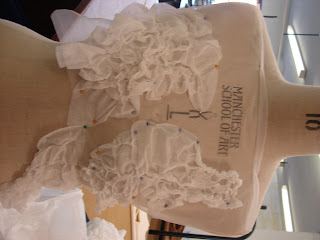I started experimenting with creating a mould out of paper then painting with the latex. This worked really well, and it was fun so see the changes in colour and texture as the latex dried.
It is a quick technique once it is started, but it does take a while to create the mould to cast the latex onto.
It's hard to keep this technique tidy, but is a lot of fun peeling the latex from the mould. The paper did stick in some places so it wasn't just latex by the end. You also need a lot of layers to make the latex thick enough to have enough strength. The layers do dry quickly though.
1st attempt of putting the latex onto the body. I thought mixing latex and the tyvek together would work, but I don't like the different colours together. The gament also has too much structure, I think there needs to be some loosness and connetion to fabric. Done some research into melted rock and lava, which relates well to the latex samples: creating a solid from a liquid.
I like the idea of the garment flowing, there's movement. The connection between fabric and plastic works well and reminds me of maybe different rock plates meeting, a joining of two very different materials.
Connecting the fabric with latex again. I created rips and scores in the fabric and pleated where it joined to the latex which manage to mirror eachother more. I also managed to relate the hand processes to this project finally because all the sewing is hand done and I have incorporated drawn threadwork to add texture.
Where the latex and fabric meet. I liked hand sewing this seam because it was quick and created moore interest by being messy. I also like the relationship of colours, they blend well together and bring two very different materials.


































